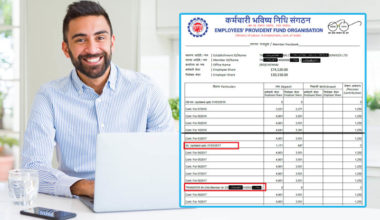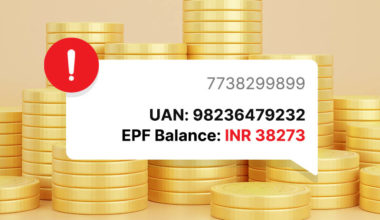EPF or Employees’ Provident Fund is a government-driven way to influence working individuals to save for retirement. Let’s dig deeper into how this fund started and how it allows people to save for the betterment of their old age.
The History of EPF
The Employee’s Provident Fund was launched by the Ministry of Labour & Employment in 1952. The ministry has been actively managing and implementing this fund since the time for the promotion of savings among the working professionals in the country.
- The idea behind implementing this scheme was to provide the employees with social security and a secure future as a reward for their hard work and dedication to the organizations
- EPF was implemented under the Employees’ Provident Funds Act as a compulsory contributory fund for all working professionals
All You Need to Know About EPF
Explained below are a few important points that you must know about Employees’ Provident Fund-
- As the law states, any business that has equal to or more than 20 employees is bound to enroll under the Employees’ Fund Provident Organization
- There is only one individual EPF account for every employee
- Both the employer and the employee contribute 12% of each of the employees’ dearness allowance and basic salary to the EPF on a monthly basis
- Employees can withdraw a part of their EPF after a year of working, but only in case of emergency
- The employers of NGOs contribute 10% of the employee’s dearness allowance and basic salary towards EPF
- The funds accumulated in the employee’s EPF are accumulated with an interest of 8.5%
- EPF withdrawals made before 5 years of employment are subject to a tax deduction of 10% of the employee’s EPF balance
Benefits of EPF
Following are some of the reasons why it is for your good to invest in the Employees’ Provident Fund- a compulsory contributory fund for all working professionals-
- The use of EPFO allows easy redressal of compliance and grievance for employees
- Since the Employees’ Provident Fund is governed by a statutory body, it is mandatory for all organizations to follow all rules and regulations set up by EPFO on a daily basis
- EPFO makes the availability of online services available easily
- With the help of EPF, the claim settlement time has been reduced from 20 days to 3 days
- EPF facilitates the promotion and encouragement of all sorts of voluntary compliance
- For employees, EPF allows them to save a lot of money in the long run
- Monthly contribution to EPF makes it easier for working professionals to save a good amount of money for their requirements, as they do not have to take out a lump sum amount for investment
- Employees can also withdraw a part of their EPF at the time of emergencies
- EPF works as a reliable source of long-term investment for employees, whilst building a retirement corpus for them
- The part of an employee’s salary that is deducted towards EPF is a part of his/her non-tax-deductible income
- Employees can transfer their EPF corpus from one employer to another as and when they switch jobs
- EPF is a major tax-saving instrument
EPFO and its Services
Employees’ Provident Fund Organisation or EPFO is a statutory body created by the Government of India. EPFO is basically a robust governing body that came into existence as a part of the Employees’ Provident Fund.
EPFO provides various services to organizations and their employees, helping them understand various aspects of the fund. Listed below are some of the major services provided by the EPFO-
- Online Registration
Employees can easily complete the Online Registration of their Establishments (OLRE) online on the EPFO portal
- Generation of UAN Details
Employees can generate their UAN details using the EPFO online portal and then log in to the UMANG application for easy access to all PF-related information
- Online EPF Subscription
Organizations can easily make PF payments/subscriptions online
- Redressal of Grievances
EPF members can raise a complaint in case of queries regarding the settlement of pension, PF withdrawal, transfer of PF, etc.
- Online Claims Transfer Status and Passbook
EPF members can quickly check the status of their PF claims, and/or review/download their PF passbook with the help of a UAN
- Missed Call and SMS Service
Users can easily get the details of their PF account (balance, previous contribution, etc.) simply by sending an SMS (Format: EPFOHO UAN to 7738299899) or by giving a missed call at 011-22901406
Provident Fund Contribution
Employers, on behalf of their employees, make a contribution to the Employees’ Provident Fund. This contribution, however, is divided into various categories and in varied ratios. The following table explains the employer’s contribution to each category along with the percentage contributed-
| Category | % of Contribution |
|---|---|
| Employees’ Provident Fund (EPF) | 3.67% |
| Employees’ Pension Scheme (EPS) | 8.33% |
| Employees’ Deposit Link Insurance Scheme (EDLIS) | 0.50% |
| EPF Admin Charges | 1.10% |
| EDLIS Admin Charges | 0.01% |
It is important to note that it is mandatory for both, the employer and the employee to contribute an equal portion of the employee’s dearness allowance and basic salary towards the EPF. The employer contributes 12% of the employee’s salary to EPF. Similarly, 12% of the employee’s salary is deducted by the employer as a monthly contribution towards EPF.
Eligibility Criteria for Employees’ Provident Fund
The following criteria must be met in order to be eligible for the EPF-
- Salaried employees with a monthly salary of Rs. 15,000 or more must register for an EPF account
- Organizations with equal to or more than 20 employees must enroll for the EPF scheme
- All the states and union territories in India, except for Jammu & Kashmir and avail the benefits of the EPF scheme
Interest Rate on EPF
The interest rate on EPF for the financial year 2022-2023 is 8.15%.
It is worth noting that the EPFO changes the interest rate on EPF at the end of every year. Once the financial year ends, the interest on EPF balance is calculated for the month-wise closing balance and then for the entire financial year.
To Conclude
EPF or Employees’ Provident Fund is a government scheme set up by the EPFO under the guidance of the Ministry of Labor & Employment. The idea behind this scheme was to promote a sense of savings among the employees and to help them build a sufficient retirement corpus for their well-being. Both the employers and employees contribute 12% of the employee’s salary to EPF. Similarly, 12% of the employee’s salary is deducted by the employer as a monthly contribution towards EPF.










